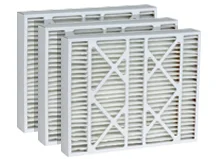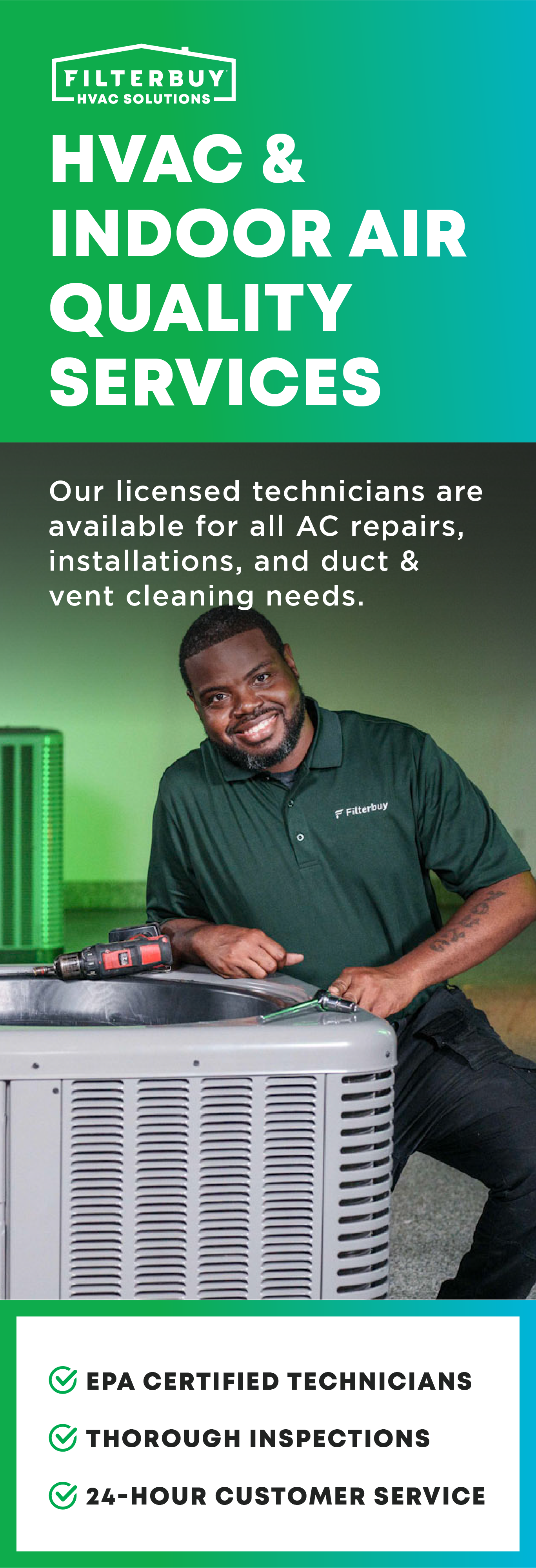Are you struggling with seasonal allergies? Feeling frustrated by itchy eyes, runny noses, and other allergy symptoms? If so, you're not alone. This post will explore the causes of seasonal allergies and how air filters can help manage these symptoms. We'll also delve into MERV ratings and how they can impact indoor air quality.
Key Takeaways
- Improved Indoor Air Quality: Air filters trap allergens like dust, pollen, and pet dander, reducing exposure to common triggers of seasonal allergies and potentially improving overall indoor air quality.
- Targeted Filtration Options: Different types of air filters, such as HEPA filters and activated carbon filters, cater to specific allergen types and sizes, allowing you to choose the filter that best targets your allergy concerns.
- Performance Matters: Choosing the right air filter based on filter efficiency (MERV rating) and room size can significantly impact indoor air quality and allergy relief, ensuring the filter effectively captures allergens relevant to your needs.
- Maintain Peak Performance: Regular maintenance and replacement of air filters are essential to ensure optimal performance in reducing allergy symptoms. A clogged filter can't trap allergens effectively.
The Growing Impact of Seasonal Allergies in America
Seasonal allergies, also known as allergic rhinitis, are a widespread health concern affecting millions of Americans. Recent data from the CDC paints a concerning picture:
Over 50 million people in the US experience allergies each year, making it the sixth most common chronic illness.
Seasonal allergies are the most prevalent allergy type, impacting over 25% of adults and nearly 20% of children.
Allergies, both seasonal and food-related, are on the rise. Food allergies, in particular, now affect about one in thirteen children. [1]
The impact of allergies extends beyond personal discomfort. Seasonal allergies alone are responsible for an estimated 4.1 million doctor visits annually. Meanwhile, food allergies are the leading cause of anaphylaxis, a potentially life-threatening allergic reaction.
The Most Common Airborne Seasonal Allergens
Nearly every plant produces pollen. Trees, grass, and weeds are the primary sources of seasonal allergies. These plant species create fine pollen particles that travel by the wind. Larger pollens (30+ microns) tend to fall to the ground, making them less problematic for allergy sufferers than smaller pollens that float in the air and can easily make their way into your respiratory system.
Tree Pollen Allergens

- Highest Pollen Counts: Early spring
- Top Allergens: Alder, Birch, Cedar, Oak, Poplar, Willow
- Micron Size: 10 to 100 microns
Grass Allergies

- Highest Pollen Counts: Late spring, summer
- Top Allergens: Ryegrass, Bermuda grass. Timothy grass
- Micron Size: 2.5 to 55 microns
Ragweed Allergens
.jpg)
- Highest Pollen Counts: Late summer, fall
- Micron Size: Average 17 microns
How Sneaky Pollen Gets Inside
Some allergens originate inside your home. Examples include mold, pet dander, and dust. While you might think you can escape allergens by staying indoors, seasonal foes like pollen can be surprisingly sneaky. Here's how they hitch a ride into your home:
- Open Doors and Windows: This is the most obvious culprit. Fresh air is great, but during high pollen seasons, it's best to keep them closed or limit the time they're open.
- Hitchhikers on You and Your Pets: Pollen can cling to your clothes, shoes, and even your furry friend's fur. Taking off shoes at the door, keeping pets groomed, and changing clothes after spending time outdoors can help minimize allergens.
- Surprise Visitors: Pollen can sneak in on furniture, groceries, or anything else that comes from outside. Consider wiping down surfaces that have been outdoors and take steps to minimize outdoor allergens being tracked in.
Don't Despair, Relief is Possible!
Even with these sneaky invaders, air filters can be a powerful weapon in your fight against seasonal allergies. We'll explore how these filters work and how to choose the right one for your needs in the next section. If you get allergy attacks, we recommend sourcing the best home air filter for allergies possible.
Importance of Indoor Air Quality
The quality of indoor air plays a pivotal role in managing and reducing the symptoms of seasonal allergies, thus underscoring the importance of effective air filters. Poor indoor air quality could potentially exacerbate existing allergies and trigger new ones.
1. Dust and Pollen: These airborne allergens can infiltrate homes, but efficient air filters can trap these particles, preventing them from circulating indoors.
2. Mold Spores and Pet Dander: High-quality air filters can also remove mold spores and pet dander, common triggers of seasonal allergies.
3. Airborne Chemicals: Volatile organic compounds (VOCs) from household products can irritate the respiratory system. Air filters can help reduce these chemicals in the air, contributing to a healthier indoor environment.
How Air Filters Help Get Rid of Seasonal Allergies
An air filter's design allows it to capture air particles and contaminants as the air flows through the filter material. This helps purify the air, keeping contaminants out of the HVAC system and out of your respiratory system.
The key to mitigating seasonal allergies is using an air filter that can capture fine pollen particles, but not every filter has that capability.
Working Mechanism of Air Filters
Air filters act like magnets for allergy triggers. They draw in air, then trap dust, pollen, and other nasties in a fine mesh filter. The higher the MERV rating, the smaller the particles it can trap, making a big difference in your indoor air quality and reducing allergy symptoms.
READ MORE: All About MERV Ratings
The Best Air Filters for Seasonal Allergies
Pollen particles can range from 2.5 to 200 micron. The smaller the particles are the worse it is for your allergies. The smallest particles can travel the farthest and can easily make their way into your nostrils.
The goal is to use an air filter that can filter out particles as small as 2.5 microns. To figure that out, take a look at the MERV rating. It will tell you if an air filter can capture the smallest pollen particles. MERV ratings range from 1 to 20. A higher rating means it can filter out smaller particles.
Choosing the Right Air Filter for Seasonal Allergies: Forget fancy brands, focus on MERV rating. This rating indicates how small a particle the filter can trap. Aim for MERV 9-12 to capture most pollen (as small as 1 micron). Higher MERVs restrict airflow and aren't necessary for allergies.
Air Filter Maintenance
No air filter lasts forever. You’ll either need to replace the air filter or clean it (depending on the filter material and design.) Upkeep is essential, as once an air filter is full, it can no longer clear contaminants out of the air. This means that seasonal allergies could make their way through an old air filter or no longer be filtered out if your air filter is clogged or dirty.

Air Filter Fit
Another problem that can hinder any air filter from doing its job is improper fit. The air filter needs to fit the filter compartment perfectly, or unfiltered air will flow through the HVAC system and into your home. That’s why measuring and sizing your replacement air filter is the key to maximum filtration for seasonal allergies.
Learn more about air filter or furnace filter sizes.
The Best Furnace Filter for Seasonal Allergies
As we’ve mentioned before, there’s not much difference between the terms “air filter” and “furnace filter.” What makes a great seasonal allergy air filter also makes a great seasonal allergy furnace filter. That said, they need to have a MERV rating of 9-13, fit well, and be replaced or cleaned regularly.
MERV Filters: Your Best Option for Seasonal Allergies
Start feeling relief from seasonal allergies today. Find the best air filter for allergy sufferers at Filterbuy. MERV 13 air filters and custom-size air filters are available online!
Disclaimer: This blog is for informational purposes only and is not intended to be a substitute for professional medical advice, diagnosis, or treatment. Always seek the advice of your qualified healthcare provider with any questions you may have regarding a medical condition.
FAQs: Conquering Seasonal Allergies with Air Filters
How Often Should I Replace My Air Filter to Control Seasonal Allergies?
To manage seasonal allergies effectively, it's recommended to replace your air filter every 30-60 days during high pollen periods. However, frequency may vary depending on filter type and individual allergy sensitivity.
What is the best MERV rating for allergies?
For most allergy sufferers, a MERV rating of 9-12 is ideal. These filters can trap small particles like pollen (as small as 1 micron) that trigger allergy symptoms. While higher MERV filters exist, they can restrict airflow and aren't necessary for allergen removal.
What are some other things I can do to reduce seasonal allergies besides using an air filter?
Here are some additional tips:
- Wash your hands and face regularly, especially after spending time outdoors.
- Clean your home regularly, including dusting and vacuuming.
- Keep windows and doors closed during high pollen seasons.
- Take allergy medication as recommended by your doctor.
- Wash your hands and face regularly
- Wash hair daily before bed
- Brush off pets outside before bringing them indoors
How often should I replace my air filter?
Replace your air filter every 30-60 days during peak allergy seasons. If you have pets or smoke indoors, you may need to replace them more frequently.
Do I need a HEPA filter for seasonal allergies?
Not necessarily. HEPA filters (MERV 17-20) are very effective at capturing even the tiniest particles, but they can also be expensive and restrict airflow. MERV 9-12 filters are a good balance for most allergy sufferers.
Where can I buy air filters?
Air filters can be purchased online or at most hardware stores and home improvement centers.
HAVE YOU MET YOUR MERV MATCH? TAKE THE QUIZ
Source: How many people in the United States suffer from allergies?

.webp)
.webp)
.webp)
.webp)









 MERV 8 AIR FILTERS
MERV 8 AIR FILTERS  MERV 11 AIR FILTERS
MERV 11 AIR FILTERS  MERV 13 AIR FILTERS
MERV 13 AIR FILTERS .jpg)



